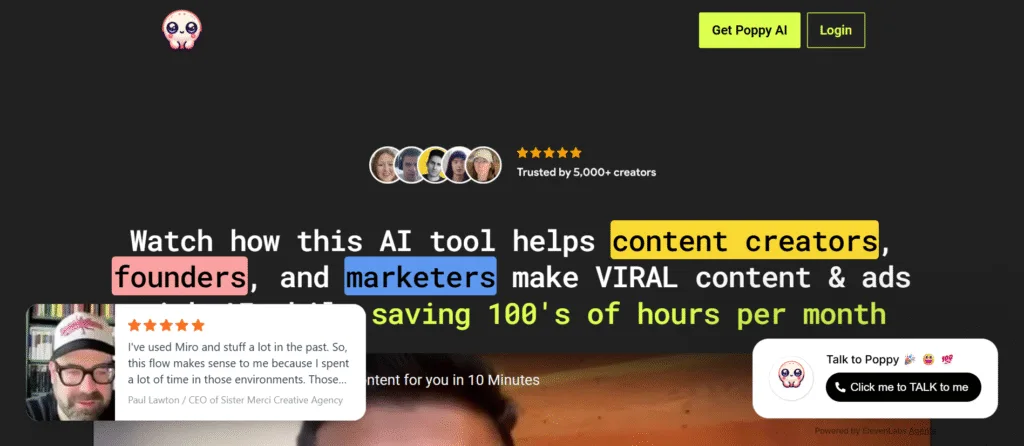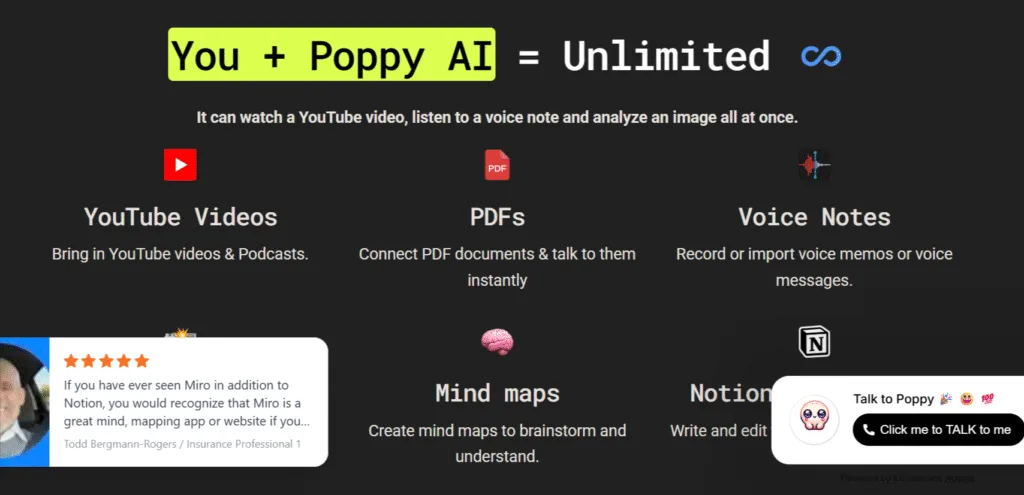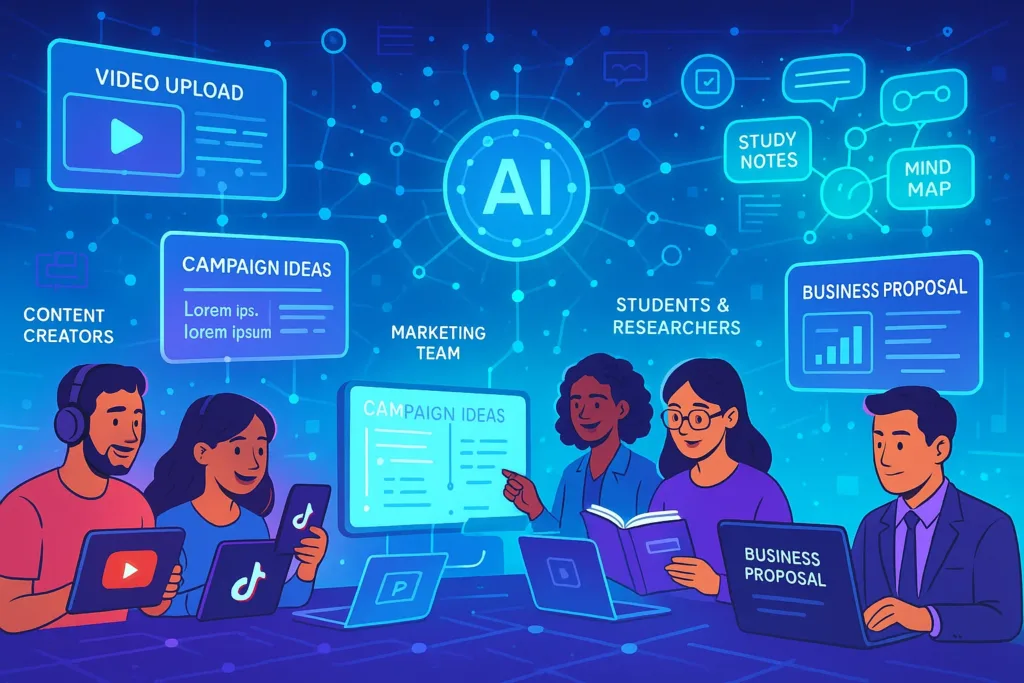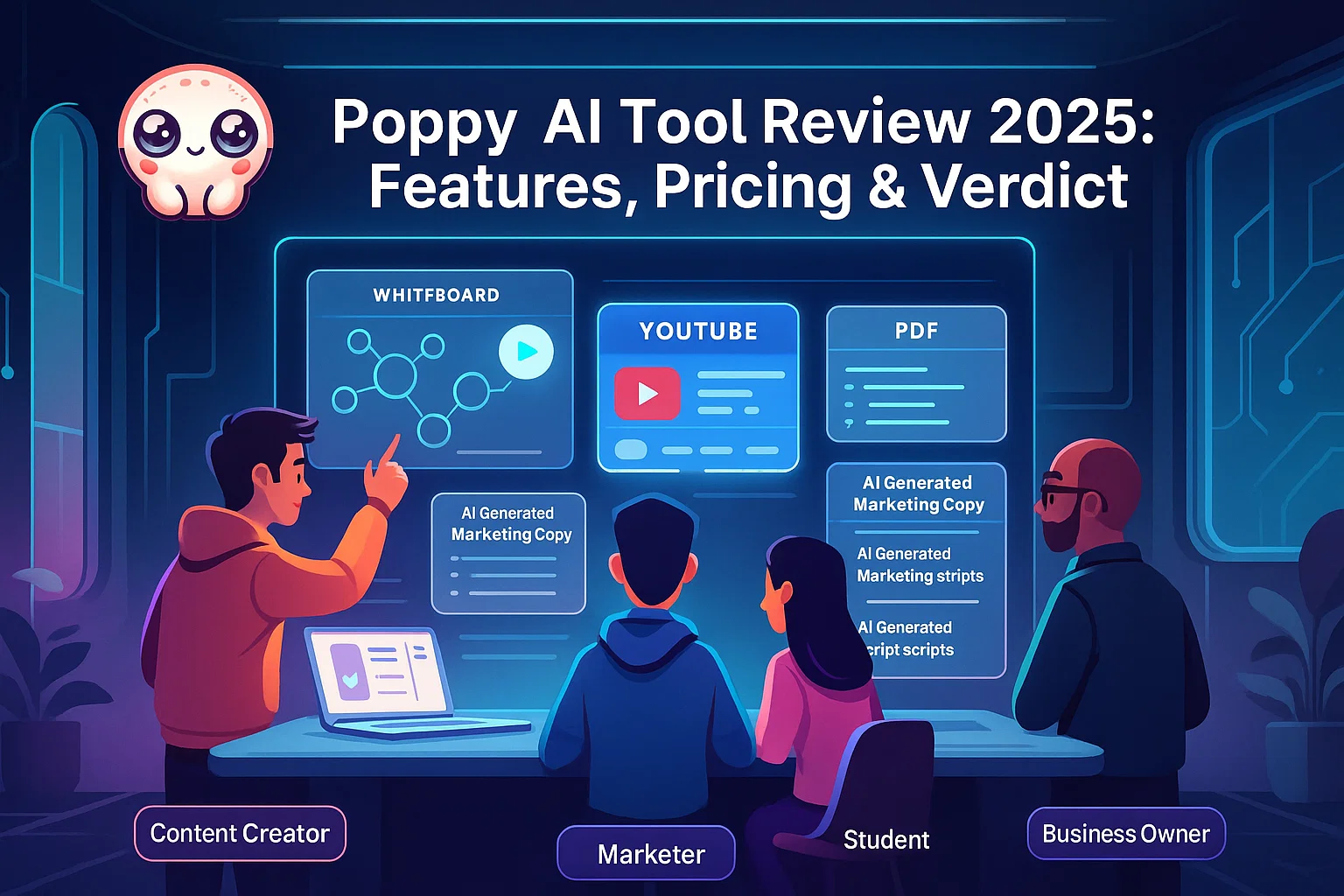Introduction
Welcome to our Poppy AI Tool Review 2025, where we take a close look at one of the most unique AI productivity tools available today. Poppy AI is not just another chatbot or AI writing tool—it’s designed as the first multiplayer AI workspace that makes collaboration easy and creative.
Unlike traditional platforms such as ChatGPT or Claude, Poppy AI focuses on teamwork, brainstorming, and multimodal inputs like videos, PDFs, images, and podcasts. This makes it especially powerful for content creators, marketers, and agencies who want to save time and scale their output.
In this review, we’ll cover Poppy AI’s features, pricing, pros and cons, real-world use cases, and best alternatives so you can decide if it’s the right tool for your workflow in 2025.
What is Poppy AI?

Poppy AI is a next-generation AI collaboration tool built for individuals and teams who want to go beyond simple prompts. Unlike most AI writing tools that focus only on generating text, Poppy offers an interactive workspace where users can work together in real time—almost like a Figma for ideas.
According to its creators, Poppy is the world’s first multiplayer AI platform. That means multiple users can brainstorm, write, or plan inside the same document with the help of AI. This unique design makes it perfect for remote teams, content creators, agencies, and educators who need both creativity and structure.
One of Poppy’s biggest strengths is that it supports multimodal inputs. You can upload a YouTube video, PDF file, image, or podcast, and Poppy AI will analyze it, summarize it, and even create new content around it. For visual thinkers, the platform also includes whiteboards, mind maps, and flowcharts, making it stand out from tools like ChatGPT, Notion AI, or Claude.
In short, Poppy AI is not just another chatbot—it’s an AI productivity workspace that combines collaboration, creativity, and multimodal intelligence in one platform.
Key Features of Poppy AI

Poppy AI comes packed with features that make it stand out from other AI content creation tools. Here’s a breakdown of its most powerful capabilities:
🔹 Multiplayer AI Collaboration
Poppy is the first multiplayer AI platform, allowing multiple people to work on the same project simultaneously. Think of it like Google Docs + AI—everyone can edit, brainstorm, and create content together, making it perfect for remote teams and agencies.
🔹 Multimodal Input Support
Unlike many AI writing assistants that only handle text, Poppy accepts YouTube videos, PDFs, images, podcasts, and voice notes. The AI can summarize, analyze, or repurpose this content into articles, scripts, or social media posts. This feature is especially useful for researchers, students, and marketers.
🔹 Visual Whiteboard & Mind Maps
Poppy includes a whiteboard AI tool where users can create mind maps, diagrams, and flowcharts. This makes it an ideal AI tool for brainstorming sessions, planning workflows, or visually organizing ideas.
🔹 Notion-Like Editor
For writers, Poppy provides a clean, Notion-style editor where you can draft blog posts, scripts, or reports. Unlike standard editors, Poppy integrates AI directly into the writing process, helping you with outlines, corrections, and content expansion.
🔹 Viral Content Generation
Poppy is popular among content creators on YouTube, TikTok, and Instagram because it can transform raw ideas into scripts, captions, and strategies. Many users report that they’ve created viral content by letting Poppy brainstorm hooks and engagement tactics.
🔹 Collaboration Across AI Models
Poppy doesn’t limit you to one model. You can integrate ChatGPT, Claude, and other AI models within the same workspace. This flexibility lets you pick the best engine for each task—whether that’s writing, analysis, or summarization.
How Poppy AI Works in Real Life

One of the main reasons users are excited about Poppy is its ability to blend AI collaboration with real-world productivity. Instead of just asking a chatbot for answers, you can use Poppy as a creative workspace where ideas turn into finished projects.
Here are some practical examples of how people are using it:
🔹 For Content Creators
YouTubers and TikTok influencers use Poppy to upload videos or podcasts, then let the AI summarize the content into scripts, captions, or social media posts. This saves hours of manual writing and helps creators stay consistent with uploads.
🔹 For Marketing Teams
Agencies rely on Poppy as an AI brainstorming tool to generate ad copy, campaign strategies, and viral content ideas. Since the platform supports multiplayer collaboration, team members can contribute in real time—just like in a virtual office.
🔹 For Students & Researchers
Students use Poppy to upload PDFs, textbooks, or research papers. The tool can highlight key points, create study notes, or build visual mind maps. Researchers can even compare data across sources without switching apps.
🔹 For Businesses & Agencies
Startups and small businesses use Poppy to streamline workflows. From drafting proposals to creating marketing content or planning product launches, the AI reduces the need for multiple tools, saving both time and cost.
In real-world usage, many users report saving 10+ hours per week by letting Poppy handle repetitive tasks. For creators, that time translates into more output; for agencies, it means scaling client projects faster.
Pros & Cons of Poppy AI
Like any other AI productivity tool, Poppy AI has its strengths and limitations. Understanding both sides will help you decide if it’s the right choice for your workflow in 2025.
✅ Pros of Poppy AI
- Multiplayer AI collaboration lets multiple users brainstorm and edit in real time, making it ideal for remote teams and agencies.
- Supports multimodal inputs (videos, PDFs, images, podcasts), which most AI writing tools lack.
- Offers a visual whiteboard and mind mapping tool for creative thinkers and students.
- Integrated Notion-style editor makes writing, editing, and organizing content seamless.
- Helps content creators produce scripts, captions, and viral ideas quickly.
- Saves 10+ hours per week by automating repetitive research and writing tasks.
- Integrates with multiple AI models (ChatGPT, Claude, etc.), offering flexibility.
❌ Cons of Poppy AI
- May feel overwhelming for beginners who only need a basic AI writing assistant.
- Pricing might be higher compared to some entry-level AI content tools.
- Best suited for teams and professionals—solo users may not use all features.
- Requires a stable internet connection to access real-time collaboration features.
Poppy AI Pricing & Plans
Understanding how much you’ll pay — and what you actually get — is central when choosing an AI collaboration tool. Here’s a breakdown of what Poppy AI offers, how their pricing tiers are structured, and whether they deliver value for different user types.
Pricing Overview
From what is publicly known:
- Poppy AI doesn’t offer a freemium plan as of now. There is no free trial.
- However, they do have a 30-day money-back guarantee. If you’re not happy, you can request a refund within 30 days.
- The pricing is credit-based: you get a monthly credit allocation. Using certain features (video analysis, PDF uploads, etc.) consumes credits. If you exceed your credits, you may need to wait until the next period or upgrade.
Known Pricing Tiers
Here are the pricing tiers according to various sources (could vary depending on promotion / region):
| Plan | Price | What You Get | Notes / Limitations |
| Annual Plan | ~$324/year (≈ $27/month) | ~2,000 credits/month; access to all features, video/podcast/PDF/image uploads, visual workspace & multiple AI model access. | Annual commitment; credits cap matters for power users. |
| Monthly Plan | ~$99/month | Same general feature set; likely same credit limit (~2,000) | Much more expensive monthly; no long-term discount. |
| Starter / Preferred / VIP Annual Plan | ~ $399/year (Starter) / $757/year (Preferred + VIP live dedicated support) | More credits, extra support & perks for higher-tiers. | Higher cost; may require payment upfront annually. |
| Lifetime / One-Time Payment Plan | ~$997-1,297 one-time payment | Lifetime access; some reports include 1:1 coaching or VIP support. | Only useful if you plan to use it for long term; may not include unlimited credits forever (check details). |
Things to Watch Out For
- Credit limits: Even with top plans, monthly credits might be a bottleneck for heavy users. If you process many videos / large PDFs / many collaborative tasks, credits might run out.
- Transparency: Some sources mention that credit allocations for higher-plans may not always be clearly stated.
- Long-term commitment: Many attractive prices are locked behind annual payment. If you’re unsure, check if the refund policy is reliable.
✅ Who Each Plan Might Be Best For
| User Type | Recommended Plan | Why |
| Casual Creators (occasional social media posts, small content) | Lower tier or starter / annual plan | Enough features without overpaying; credit limits less likely to bite. |
| Regular Content Makers / Marketers | Annual Plan or Preferred / VIP | Access to all features, more credits, better support. Helps with viral content generation and frequent multimedia uploads. |
| Teams / Agencies | Higher annual or VIP / Lifetime plan | Need more collaboration & credits; better value over time; stronger support. |
| Researchers / Students | Annual Plan (top credit) | Useful for media & document analysis; visual workspace helps with studying. |
Value & ROI Discussion
- If you are someone who spends many hours per week researching, generating content, analyzing media etc., the time saved can justify the cost.
- The visual workspace + multiple AI model access can replace or reduce spending on several other tools (video transcript tools, content planners, document analyzers).
- But if your usage is low (say a few social media posts per week), the cost per credit or hour saved may not justify going beyond a basic plan.
Comparison: Poppy AI vs ChatGPT vs Claude AI vs Notion AI
| Tool | Starting Price / Tier | Key Features | Pros Compared to Others | |
| Poppy AI | ~ Annual / Premium plans (credit-based model). Full features include multiplayer collaboration, support for multimodal uploads (video, PDF, podcast, image), visual workspace (whiteboard / mind maps), and access to multiple AI models. | • Highly suited for team collaboration and creative workflows. • Strong in handling multimedia inputs. • Visual & interactive workspace helps with brainstorming. • Integrated features reduce need for multiple tools. | • Less mature brand recognition than OpenAI or Anthropic. • Higher cost for heavy multimedia users (credits may run out). • Might be over-kill for simple text-based tasks. | |
| ChatGPT (OpenAI) | Free tier available; Plus ~$20/month gives priority access & better features. Also higher/business/enterprise plans. | • Extremely versatile, broad model access (GPT-4/GPT-5 etc), frequent updates. • Strong ecosystem, plugins, agents, handling of text, voice, image, etc. • Reliable for many general tasks (chat, content generation, summarization etc.). | • Not specifically made for multiplayer brainstorming & visual whiteboards (though integrations exist). • Does not always optimize for media uploads or mind-map style workflows. • Credits or usage limits might throttle heavy usage in certain plans. | |
| Claude AI | Free tier + Claude Pro (~$20/month) etc. | • Strong writing quality, reasoning, creative tasks. • Good competitor to ChatGPT in terms of clarity, safety, etc. • Some offer long context windows. | • Less emphasis on visual collaboration or multimodal inputs (video/image etc) compared to Poppy. • Fewer “workspace-style” tools like whiteboards or mind maps. | |
| Notion AI | Starting price ~ $10/month for AI add-on / built into higher plans (Business / Enterprise) depending on region. | • Excellent for document organization, note taking, databases, integrating content & knowledge management. • Great for workflows that combine writing + project management. • Familiar, clean interface especially for those already using Notion. | • Less strong in multimedia / video / podcast processing compared to tools focused on those inputs. • Not built for real-time multiplayer brainstorming workspace or deep visual whiteboard tools by default. • AI features may be limited on lower plans or require upgrade. |
Insights / Which Tool Might Be Best For Whom
- If you want strong multimedia input processing + visual brainstorming + team collaboration: Poppy AI likely gives more of those out-of-the-box.
- If you already use Notion and need neat organization, databases, embedding AI into note/project workflows: Notion AI may be more cost-efficient.
- For general purpose / wide adoption & continual feature growth: ChatGPT is still very strong.
- For high writing quality, safe reasoning, and clarity: Claude AI is a great contender.
Who Should Use Poppy AI?
Not every AI productivity tool is built for the same audience. Some are better for individuals, while others shine when used by teams. Poppy AI sits in the second category, designed to maximize its value in collaborative and creative environments.
Here’s who can benefit the most from Poppy AI:
🔹 Content Creators
YouTubers, TikTokers, bloggers, and podcasters who need help turning raw ideas into finished scripts, captions, and viral content will love Poppy’s multimodal AI features.
🔹 Marketing Teams & Agencies
Poppy is ideal for marketing professionals who run ad campaigns, brainstorm strategies, and manage multiple clients. The multiplayer AI collaboration makes it easy to create campaigns together in real time.
🔹 Students & Researchers
Anyone working with PDFs, textbooks, or large reports can use Poppy to generate summaries, study notes, and mind maps. This is especially helpful for visual learners who prefer diagrams over long text.
🔹 Small Businesses & Startups
For businesses with limited resources, Poppy can replace multiple tools—serving as a content generator, research assistant, and planning platform all in one. It reduces costs while boosting productivity.
❌ On the other hand, Poppy AI may not be ideal for:
- Casual users who only need a basic AI writing assistant for short texts.
- Budget-conscious users who don’t want to commit to higher subscription fees.
- People who rarely collaborate or don’t need multimodal features.
Poppy AI Alternatives & Competitors
When choosing an AI tool, it helps to know what else is out there. Here are several alternatives to Poppy AI — each with its own angle. This helps readers decide which tool best fits their workflow, budget, and needed features.
Top Alternatives to Poppy AI
| Tool | What It Does Best / Unique Edge | How It Compares to Poppy AI (Strengths) | Weaknesses vs Poppy AI |
| Simplified | All-in-one design + copy + video editing + templates + team collaboration. G2 lists it as the best overall alternative to Poppy AI. | Easier for beginners; strong in design & template-driven content; may have more polished UI & lower learning curve. | Might not have as deep multimodal input support (video, podcasts, mind maps) or the multiplayer whiteboard style workspace that Poppy offers. |
| Canva | Strong in graphics, video, design; excellent for social media visuals & templated design work. | Very strong for visual content creation; huge template library; good brand recognition. | Less focused on combining all input types (PDF / audio / image / video) into one research-driven workspace; weaker in AI collaboration / brainstorming flows vs Poppy. |
| Jasper | Long-form writing, content generation with many templates, strong for blog posts, marketing copy. | Excellent writing quality; mature product; robust support and integrations; good for traditional content creators. | Often more expensive; fewer visual / mind-map style tools; less powerful multimedia content ingestion (video / podcast / etc.) compared to Poppy. |
| Apollo.io | Sales & marketing automation + outreach tools; integration with contact & lead management. | Helpful if you combine content + outreach; more business-oriented features; good for those needing marketing plus content. | Not primarily built for creative whiteboard / visual collaboration; may have less emphasis on content-creation pipelines with multimodal input. |
| Creatify AI | AI tools for visuals, content generation; useful for quick design + content workflows. | Strong visual content generation + design-first features; likely fast for social media content. | May not provide same level of research tools, video/podcast/ PDF ingestion, or persistent collaborative boards like Poppy; might be less suited for large-scale, deep content with many input types. |
| AI Flow Chat | Offers a similar whiteboard + chat experience; adds reusable workflows, automation, monthly pricing. | More flexibility in pricing; ability to reuse workflows; good if you need to standardize or scale content production. | Depending on its maturity, may lack polish; may not yet have as many users or integrations as Poppy; possible limitations in multimodal inputs or performance. |
Key Criteria: What Alternatives Get Right vs Where Poppy AI Is Stronger
To help readers see the trade-offs, here’s a summary of where Poppy AI typically outperforms many alternatives, and where people might prefer the alternatives instead:
| Feature | Where Poppy AI Excels | Where Alternatives May Be Better |
| Multimodal input (videos, PDFs, images, podcasts) | Poppy supports ingesting many kinds of media in the same workspace. | Many alternatives focus more on text + images + design, less on video/podcast analysis; so if your content is mainly writing & design, alternatives may suffice. |
| Visual workspace / mind maps / whiteboards | Poppy gives creators visual mapping & brainstorming tools. | Tools like Canva & Simplified are great for design but weaker on visual organization & brainstorming across mixed media. |
| Multiplayer collaboration | Real-time collaboration and shared workspaces are core to Poppy. | Some alternatives have collaboration too, but may not be as tailored or fluid for creative team workflows with mixed media. |
| Ease of design / visuals | Poppy is strong, but design features are not as extensive or simplified as Canva or Simplified. | Alternatives like Canva, Simplified have large template libraries, graphics, etc., which make design faster for non-designers. |
| Pricing flexibility | Some users note Poppy’s pricing is more locked-in (annual payments, etc.) and credit-based. | Some competitors provide more monthly plan options, free tiers, or more transparent pricing for lower/entry usage. |
| Brand maturity & user base | Poppy is newer; fewer users compared to giants like Canva, Jasper etc. May have minor limitations / UI polish. | Alternatives often have bigger teams, more integrations, more stable / tested features. |
Which Alternative to Pick Based on Your Needs
- If you want design + visuals + quick social media content, Canva or Simplified might be better fits.
- If your priorities are long-form writing, SEO content, marketing blog posts, Jasper is solid.
- If you want something very similar to Poppy (whiteboard style + mixed media inputs + reuse/workflow automation), AI Flow Chat looks promising.
- For teams doing outreach or combining content + sales/marketing, Apollo.io or similar tools that integrate outreach features might be helpful.
User Testimonials & Success Stories
One of the best ways to judge an AI collaboration tool is by looking at how real users are benefiting from it. Poppy AI has already attracted 6,000+ active users, including content creators, marketers, students, and businesses who use it daily to save time and improve results.
🔹 Content Creators
Many YouTubers and TikTok influencers report that Poppy AI helped them create viral content by quickly turning raw video ideas into scripts, captions, and thumbnails. Some creators claim that using Poppy has boosted their engagement by 2x to 3x within weeks.
🔹 Marketing Agencies
Agencies say Poppy allows them to brainstorm ad campaigns in real time, with each team member contributing inside the same workspace. This has cut down planning time and helped deliver client-ready campaigns faster.
🔹 Students & Researchers
Students appreciate Poppy’s ability to generate summaries, study notes, and mind maps from large PDFs and textbooks. Researchers also highlight how it helps compare sources, making academic projects less time-consuming.
🔹 Small Businesses
Entrepreneurs and startups mention that Poppy AI has replaced multiple tools in their workflow. Instead of paying separately for content writing apps, whiteboards, and research assistants, they rely on Poppy for all-in-one AI productivity.
Overall, user feedback suggests that Poppy AI isn’t just a theoretical productivity tool—it’s actively helping people save 10+ hours per week, grow their businesses, and scale creative projects with less effort.
Final Verdict: Is Poppy AI Worth It in 2025?
After going through its features, pricing, pros & cons, and user feedback, it’s clear that Poppy AI is more than just another AI writing assistant. It’s positioned as a complete AI collaboration workspace that helps teams and individuals manage brainstorming, writing, and media analysis in one place.
If you’re a content creator, marketer, student, or small business owner, Poppy AI can save you time, boost creativity, and replace multiple tools with a single platform. Features like multiplayer collaboration, multimodal inputs (videos, PDFs, images, podcasts), and visual mind maps make it stand out from traditional tools like ChatGPT, Claude, or Jasper.
However, Poppy may not be the best fit for casual users who only need a simple AI copywriting tool for short texts, or for those on a tight budget. The credit-based pricing and annual plans require commitment, which is better suited to people who use AI regularly in their workflows.
FAQs About Poppy AI
Is Poppy AI free to use?
No, Poppy AI is not free. It works on a subscription model with credit-based pricing plans. Users need to choose a plan that fits their needs. However, it does offer a 30-day money-back guarantee, allowing you to test the platform risk-free.
What makes Poppy AI different from other AI writing tools?
Unlike many AI writing assistants, Poppy AI is designed as a multiplayer AI collaboration tool. It supports multimodal inputs such as YouTube videos, PDFs, podcasts, and images, while also providing a visual whiteboard and mind mapping tool. This makes it especially powerful for teams and creators who work on complex projects.
Can Poppy AI replace ChatGPT or Claude?
Not exactly. While ChatGPT and Claude are excellent for text generation, Poppy AI combines collaboration features, brainstorming tools, and multimodal content analysis. Many users find value in using Poppy alongside ChatGPT or Claude, depending on the task.
Who should use Poppy AI?
Poppy AI is best suited for content creators, marketing teams, researchers, students, and small businesses who want to save time and streamline their workflows. It may not be ideal for casual users who only need a basic AI copywriting tool for occasional use.
How safe is my data with Poppy AI?
Poppy AI emphasizes data privacy and ensures user content is processed securely. Still, as with any AI productivity platform, it’s recommended not to upload highly sensitive or confidential information without reviewing the company’s privacy policy.

